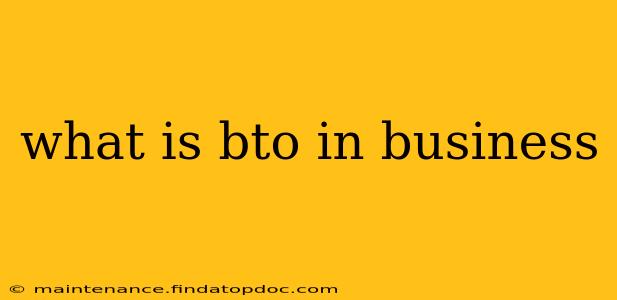In the dynamic world of manufacturing and business, understanding acronyms is crucial. BTO, or Build-to-Order, represents a powerful production strategy that's gaining significant traction. But what exactly is BTO in business, and how does it differ from other manufacturing models? This comprehensive guide will delve into the specifics, exploring its advantages, disadvantages, and ideal applications.
What Does BTO Mean in Business?
BTO, short for Build-to-Order, is a manufacturing process where products are only produced once a customer order is received. Unlike mass production, where goods are manufactured in advance based on sales forecasts, BTO involves assembling or manufacturing items specifically to meet individual customer specifications. This means no inventory is built until a customer places an order, creating a unique, tailored experience for the buyer.
How Does BTO Work in Practice?
The BTO process typically involves several key steps:
- Order Placement: A customer places an order, specifying their desired product configuration, customizations, and delivery details.
- Order Processing: The order is processed, verified, and entered into the manufacturing system.
- Component Procurement: If necessary, components are sourced and procured. In some cases, many components might already be in stock, speeding up production.
- Manufacturing/Assembly: The product is manufactured or assembled according to the customer's specifications. This may involve a combination of automated and manual processes.
- Quality Control: Rigorous quality control checks are implemented to ensure the product meets the required standards before shipment.
- Packaging and Delivery: The finished product is packaged and shipped to the customer.
Advantages of BTO Manufacturing
The BTO model offers several compelling advantages for businesses:
- Reduced Inventory Costs: By only producing what's ordered, businesses drastically minimize warehousing costs and the risk of obsolete inventory.
- Increased Efficiency: Resources are focused on producing exactly what customers want, minimizing waste and maximizing efficiency.
- Enhanced Customer Satisfaction: BTO caters to specific customer needs and preferences, leading to increased satisfaction and brand loyalty.
- Higher Profit Margins: The elimination of inventory holding costs can lead to higher profit margins.
- Customization Opportunities: Allows for a wide range of product customization, appealing to a broader market segment.
- Lower Risk of Obsolescence: Since products aren't produced until ordered, the risk of outdated inventory is significantly reduced.
Disadvantages of BTO Manufacturing
While BTO offers many benefits, it's important to acknowledge potential drawbacks:
- Longer Lead Times: Customers may experience longer waiting times compared to readily available products.
- Higher Production Costs per Unit: Setting up for smaller production runs can sometimes lead to slightly higher costs per unit.
- Inventory Management Complexity: While inventory holding costs are reduced, managing the supply chain for on-demand production requires efficient planning and control.
- Demand Forecasting Challenges: Accurate demand forecasting is crucial to ensure smooth operations and avoid production bottlenecks.
What Industries Benefit Most from BTO?
BTO is particularly well-suited for industries where customization is key or where demand forecasting is challenging:
- Computer Manufacturing: Custom configurations of PCs and laptops are a perfect example.
- Apparel and Footwear: Personalized designs and sizes are frequently produced using a BTO approach.
- Furniture Manufacturing: Custom-made furniture tailored to specific room dimensions and styles utilizes BTO principles.
- Automotive Industry: While not entirely BTO, many car manufacturers offer extensive customization options, leaning towards a build-to-order strategy.
Is BTO Right for Your Business?
The suitability of BTO depends largely on your industry, target market, and production capabilities. Carefully weigh the advantages and disadvantages, considering factors like:
- Demand variability: Can you accurately predict demand, or is it highly unpredictable?
- Production capacity: Do you have the resources and flexibility to handle on-demand production?
- Lead time tolerance: Are your customers willing to wait longer for customized products?
- Cost structure: Can you afford the higher per-unit production costs?
By thoroughly analyzing these factors, you can determine if adopting a BTO strategy aligns with your business objectives and customer expectations.
What are the differences between BTO and other manufacturing models?
BTO differs significantly from Make-to-Stock (MTS) and Configure-to-Order (CTO). MTS produces goods in advance based on demand forecasts, while CTO offers customization options within a pre-defined range of configurations. BTO, on the other hand, produces items only after receiving a specific customer order. This key distinction sets it apart, prioritizing customer-specific needs over mass production or limited customization.
What are the key challenges of implementing BTO?
Implementing BTO successfully requires careful planning and management. Key challenges include accurate demand forecasting, efficient supply chain management, effective production scheduling, and maintaining high-quality control throughout the process. Overcoming these hurdles requires robust IT systems, strong communication channels, and a highly skilled workforce.
What are some examples of companies using BTO?
Many large and small companies employ BTO strategies, though they often don't explicitly label themselves as such. Think of companies specializing in custom-designed clothing, bespoke furniture makers, or high-end audio equipment manufacturers. The core principle remains consistent: production begins only after a customer order is placed with specific requirements.
By understanding the intricacies of BTO manufacturing, businesses can make informed decisions about their production strategies, leading to improved efficiency, higher customer satisfaction, and ultimately, enhanced profitability.
